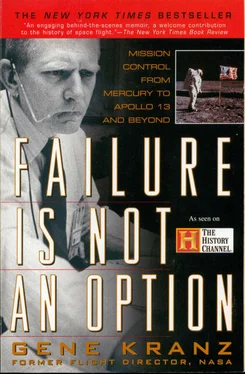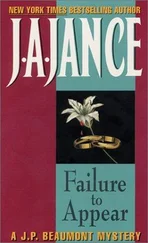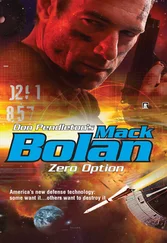In 1988, after the Challenger accident, we made a change in the Mission Control emblem, inserting a comet, a symbol of risk and sacrifice that served as a reminder of the individuals who gave their lives for space exploration. We lost astronauts and we lost controllers, among them Cliff Charlesworth, Dick Thorson, Tec Roberts, Carl Huss, Ted White, Scott Hamner, and many others. We also lost Bill Tindall and many others who, though not flight controllers, made our work possible. Like comets, they all swept through the sky casting brightness in their wake—and then they were gone.
For those that remained the years were good to us.
• In 1974, I became deputy of NASA Mission Operations and in 1983, director. I continued my work in Mission Control with the controllers, flight designers, planners, and instructors and was assigned additional responsibilities for all aspects of Shuttle flight operations including design and development of MCC and simulation facilities and preparation of the Shuttle flight software.
• My final hours in Mission Control came during the December 1993 Shuttle mission to repair the Hubble Space Telescope. I retired from NASA in March 1994 and have never returned to the Mission Control room.
• In retirement I returned to aviation. I constructed an acrobatic biplane and flew as engineer on a B-17 Flying Fortress. I speak on the space program to at least sixty to seventy professional, civic, and youth groups each year.
• Chris Kraft retired from NASA in 1982. He served in many corporate and civic roles including as director-at-large of the Houston Chamber of Commerce, on the Board of Visitors of Virginia Polytechnic Institute, and on the board of the Manned Space Flight Education Foundation. He now serves as a consultant and corporate board member and is currently writing his memoirs of the space program.
• Glynn Lunney was program manager for the Apollo-Soyuz rendezvous mission, Space Shuttle program manager, and, after NASA retirement, president of Rockwell Space Operations-Houston.
• John Hodge left NASA in 1970 to study advanced transportation systems while working for the Department of Transportation. Twelve years later he reentered NASA as director of the Space Station Task Force. He retired in 1987 and founded a high-tech management consulting firm.
• Gerry Griffin became director of the Johnson Space Center, president of the Houston Chamber of Commerce, consulted on the Apollo 13 movie, and as an actor has appeared in several space-related movies.
• Jerry Bostick became Space Shuttle program deputy manager, and after NASA retirement, vice president of Grumman Space Operations. He consulted on the Apollo 13 movie and the TV miniseries From the Earth to the Moon .
• Arnie Aldrich was named the NASA headquarters director of the Space Shuttle program after the Challenger accident. He led the efforts to return the Shuttle to flight status. He then served as the associate administrator for Aeronautics, Exploration, and Technology. After retirement in 1994, he joined Lockheed’s Missile and Space Company as vice president for commercial space programs.
• John Llewellyn opened and operates a cattle and sugar cane ranch and a riverboat touring company in Belize. For a while he owned two satellites recovered during a NASA shuttle mission and today works in the telecommunications industry.
During my thirty-four years with NASA I kept notes of meetings, mission logs, voice tapes, and post-mission reports. The materials filled seven file cabinets and numerous boxes and bookshelves. When my agent, George Greenfield, approached me to write a book in the summer of 1995 I was well into the construction of an acrobatic biplane and was reluctant to divert my attention from the effort. George persisted and during a trip to Houston convinced me to commit to writing a book. George kept me moving through some difficult times and introduced me to Jim Wade and Bob Bender, who made this book a reality.
Andy Chaikin, author of A Man on the Moon, and Al Reinart, one of the scriptwriters for the Apollo 13 movie, got me started. They coached me on writing a book proposal, developing an outline, and using a storyboard.
The completed outline showed me where I needed more information to write a book on the highly complex events that occurred four decades ago. To fill the gaps I began corresponding with the controllers of the Mercury, Gemini, and Apollo programs.
• Ted White and Arnie Aldrich provided Mercury remote site team reports, technical manuals, photos, and copies of mission messages.
• Dutch Von Ehrenfried contributed manning lists and Gemini EVA mission rules.
• Chuck (Skinny) Lewis contributed Langley and MSC phone books that were invaluable in establishing the organization structure and personnel locations at critical times.
• Jay Greene provided the complete set of Tindallgrams.
• Gerry Griffin provided voice tapes that, when combined with mine, covered every Apollo mission.
• Doug Ward provided press conference transcripts and converted the reel-to-reel voice tapes to cassette.
• Glen Swanson, the NASA-JSC historian, provided biographical materials and researched events in the press transcripts.
• Many other controllers volunteered personal notes, mission rules, console logs, photos, or other memorabilia. Some just answered my questions to help me make complex problems understandable.
• The photos were acquired from many sources, including Mike Gentry in the NASA-JSC Media Resource Center. The controllers’ personal photos were processed by the One Great Photo Lab in Webster, Texas.
The technical content of the story was contained in the voice records, console logs, and mission reports; individual and group interviews were used principally to develop anecdotal data and to capture the gut feelings of the controllers.
The interviews were the most enjoyable part of writing this book. I interviewed controllers in groups to generate the emotional intensity that existed decades ago. I found that the controllers most vividly remembered the best moments, and that time had softened the edges on the bad moments. During the group sessions we sat around a cooler filled with beer, ate pizza, and reminisced. The interview sessions generally lasted about three hours and each involved seven to twelve controllers. I conducted ten group sessions with remote site teams, spacecraft systems engineers, simulation teams, the Trench, and mission designers and flight directors. I conducted individual interviews with Harold Miller (SimSup), John Hodge, Arnie Aldrich, and Ed Pavelka. Each interview was recorded on videotape.
Writing a book is a team effort and as in Mission Control, I needed a lot of help to get the job done.
Jan Pacek Weede, my NASA secretary for two decades, transcribed numerous voice tapes, and typed and updated the manuscript.
Jack Riley, my public affairs officer for many missions, helped me shape the original story and reviewed every manuscript draft.
My original draft of the book covered over 200,000 words, so Mickey Herskowitz, a Houston Chronicle sportswriter, helped me to condense the story and better focus my role in the story.
Throughout every stage of the book there were dedicated readers and reviewers, among them Ed Fendell, Gerry Griffin, Jerry Bostick, Jim Hannigan, Pete Frank, Jack Riley, Chuck Lewis, Glen Swanson (NASA Johnson Space Center History Office), Rebecca Wright and Carol Butler (NASA Johnson Space Center Oral History Project), Ralph Royce from the Lone Star Flight Museum, and my wife, Marta.
Jim Wade, formerly vice president and executive editor of Crown Publishers, accomplished the final structuring and shaping of the book. He is presently a member of the Independent Editors Group. Jim tuned, polished, and structured the manuscript. In the final months, he joined my list of the great mentors.
Читать дальше












